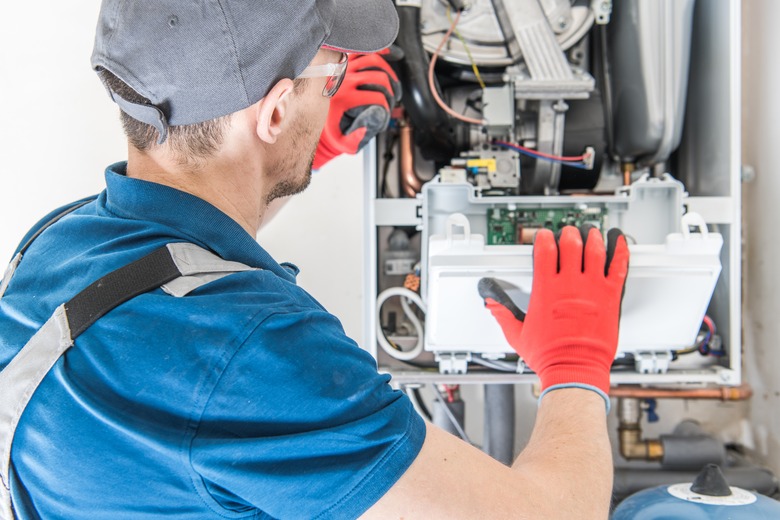How To Reset A Furnace Using The Furnace Reset Button
We may receive a commission on purchases made from links.
Knowing how to reset a furnace is an overlooked skill in the repertoire of many homeowners, and it's an important one whether you have a gas furnace, an oil furnace or an electric furnace. Almost every furnace has a reset button, which is typically located inside the blower housing next to the blower motor. When a problem occurs, such as an interruption in the gas supply, an empty oil tank or an overheated blower, the furnace reset button pops out, and you have to push it back in to restart the furnace, but there's a particular procedure to follow to do it safely.
If you don't know where your furnace reset button is located, there's no time like the present to find it so you don't have to search for it when you need it. You should be able to locate the reset button by removing the access panel from the furnace blower motor housing and looking inside. The reset button is red or yellow, and it's usually in a prominent place so it's easy to see. Depending on the furnace design, however, you may have to search a bit to find it, which is why it's important to know where it is beforehand. If you can't locate the reset button, consult your owner's manual or get an HVAC professional to help you find it.
How to Reset a Furnace Using the Reset Button
Although pushing the reset button should get your furnace or HVAC system operating again, the fuel may not begin flowing until you complete a separate procedure. Of course, the only fuel powering an electric furnace is electricity, but to be on the safe side, you should shut it off before resetting the furnace. The procedures for resetting an electric, gas or oil furnace are as follows:
1. Restart an Electric Furnace With the Reset Button
If the furnace doesn't have a power switch you can turn off, turn off the circuit breaker controlling the furnace, open the blower housing and locate the reset button on the side of the blower motor. Press it in until it clicks and then restore power to the furnace by turning the breaker back on. The furnace should start automatically as soon as it receives a signal from the thermostat.
2. Restart a Gas Furnace With the Reset Button
Make sure the pilot light is out. If it isn't, turn the gas control switch to "off" and make sure that the pilot goes out. Then, turn down the thermostat to its lowest setting. If the furnace has an electronic ignition, turn off the power by turning off the circuit breaker that controls the furnace. Turn off the main gas supply to the furnace but leave the pilot gas supply line open. In many cases, you can do this by turning the main gas control knob to "pilot" and holding in the knob.
Relight the pilot by holding a lit match or lighter in front of the pilot flame jet. If the furnace has a sealed pilot compartment, you may see a red button for piezoelectric spark ignition, and if so, press this button repeatedly until the pilot starts. If you turned off the power, turn it back on. Then, turn on the main gas supply and press the reset button. Hold it in for about 30 seconds, release it and adjust the main thermostat to its former setting.
3. Restart an Oil Furnace With the Reset Button
Determine the cause of the shutoff before resetting an oil furnace. If you had a power outage, no procedure other than pressing the reset button is necessary, but if you ran out of oil, you'll first have to fill the oil tank and bleed the fuel line. In the latter case, locate the bleeder valve on the fuel pump, which is a small black box near the burner with fuel lines running into it. Put a container under the valve that is big enough to catch at least 1 quart of fuel or run tubing from the fuel pump to a 1-quart plastic bottle.
Make sure the power is on and then open the bleeder valve and let fuel flow until there's a steady stream with no air. Then, press the reset button, which should trigger the furnace to start. When it does, close the bleeder valve and pour the excess fuel into the fuel tank.
Troubleshooting a Furnace Reset Button
You might not be able to reset the furnace by pressing the reset button, or the button may pop out repeatedly for some of the following reasons:
- The air filter may be dirty and blocking airflow. Replace the filter.
- The flame sensor may be dirty. Clean it.
- The fuel line may be clogged. Unclog it.
- The furnace may have overheated. Let it cool off before trying to restart it.
It's a rare homeowner who can handle furnace repair and furnace maintenance without professional help — so don't try to DIY it to prevent injury. Making the wrong move when flammable and volatile fuels are present can have serious consequences, as can making electrical repairs when you aren't familiar with the proper procedures. Don't hesitate to call for service when you're having problems with your heating system or your HVAC system and you don't feel confident enough to make the repairs yourself.
